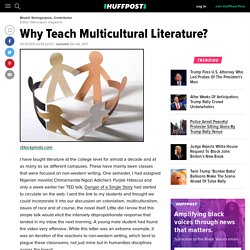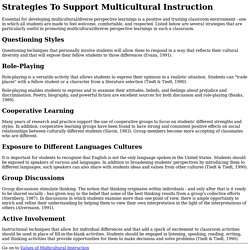

My Collection & Choices. Literature Opens Doors For All. Adolescent literacy position statement. HuffPost is now a part of Verizon Media. I have taught literature at the college level for almost a decade and at as many as six different campuses.

These have mainly been classes that were focused on non-western writing. One semester, I had assigned Nigerian novelist Chimamanda Ngozi Adichie’s Purple Hibiscus and only a week earlier her TED talk, Danger of a Single Story had started to circulate on the web. I sent the link to my students and thought we could incorporate it into our discussion on colonialism, multiculturalism, issues of race and of course, the novel itself. Little did I know that this simple talk would elicit the intensely disproportionate response that landed in my inbox the next morning. A young male student had found the video very offensive. Why teach U.S. students literature from different countries?
Here is the video that set this off, followed by the student’s letter and my response: About the Adichie talk at the TED conference. But does she mention them? Subscribe to the Black Voices email. Inclusive Literacy Infographic EBARVIA. BYU McKay School of Education. Gallery Stroll Activity Cultural Diorama Activity Mad Gab Activity Download the whole packet Benefits of Multicultural Education Activities Activities allow students to experience new things and to express their feelings.

Benefits include the following: Help educators reach students who may benefit from more hands-on or practical learning experiences Allow students to become actively involved in the learning process Encourage students to critically think about and analyze information themselves, rather than passively receiving knowledge Ways to Incorporate Multicultural Education Activities Into a Classroom Revise teaching techniques to increase the success and effectiveness of the activity Encourage all students to participate (especially during discussion) Plan adequate time to process the activity Ask open-ended questions Foster a feeling of emotional safety in the classroom by respecting every student's opinion and encouraging all students to be respectful of one another Links. Reading Diversity A Tool For Selecting Diverse Texts.
Adolescent literacies in a multicultural context (eBook, 2012) Guiding Principles for Teaching Multicultural Literature. Tricia Ebarvia: How Inclusive Is Your Literacy Classroom Really? In 1981, my family moved eighteen miles from northeast Philadelphia to the suburbs.

Because I had just turned five, my parents decided we needed to move into a better school district. This meant moving from a predominantly black neighborhood to a predominantly white one. I didn’t know it then, but it would be my first lesson in how segregation works. My parents emigrated from the Philippines in the 1970s. They were part of a professional class that came to the United States in a wave of Asian immigration after the passage of the 1965 Immigration and Nationality Act. Throughout elementary and middle school, my brother and I were among only a handful of students of color—and, if my memory is correct, we were two of only three Asian Americans in the building, in our classes, on the playground.
Inclusion Literature: Ideas for Teachers and Teacher Educators. Books That Promote Diversity and Inclusion. Diverse and Inclusive Books to Inspire Young Adults. By the time readers are young adults, their worlds have broadened to include a wide range of people and life experiences that inform their developing identities.

As teenage readers discover who they are, it's important that they have access to stories that reflect and celebrate the full range of human experiences and a diversity of race, ethnicity, sexual orientation, gender identity, physical and mental abilities, religion, and culture. The following topics and themes are explored in this list: For even more Scholastic books that explore these themes, check out our catalog, The Power of Story: Diverse Books for All Readers. Highly Recommended Diverse Books for Kids & Teens. Strategies To Support Multicultural Instruction.
Essential for developing multicultural/diverse perspective learnings is a positive and trusting classroom environment - one in which all students are made to feel welcome, comfortable, and respected.

Listed below are several strategies that are particularly useful in promoting multicultural/diverse perspective learnings in such a classroom. Questioning Styles. Multiculturalism in the Modern World: Jen Holladay at TEDxDenverTeachers. 3b835e694aeb8df7be9023b01ced1b953b73. OP cultural identity. Making Connections: Culturally Responsive Teaching and the Brain. In reality, cultural responsiveness is more of a process than a strategy.

It begins when a teacher recognizes the cultural capital and tools students of color bring to the classroom. She is then able to respond to students' use of these cultural learning tools positively by noticing, naming, and affirming when students use them in the service of learning. The most common cultural tools for processing information utilize the brain's memory systems -- music, repetition, metaphor, recitation, physical manipulation of content, and ritual. The teacher is "responsive" when she is able to mirror these ways of learning in her instruction, using similar strategies to scaffold learning. For example, a science teacher I mention in the book wasn't having much success with her sixth-grade students learning the science vocabulary. Afterwards, learning weekly vocabulary was more active and game-like.
You'll notice that there's no mention of Africa, Mexico, or race at all. Culturally Responsive Teaching & The Brain. The Windows and Mirrors of Your Child's Bookshelf. Madison Public Library. Diverse Classroom Libraries for K 6 Classrooms. Culturally Responsive Teaching: 4 Misconceptions. Missing Adventures: Diversity and Children's Literature.